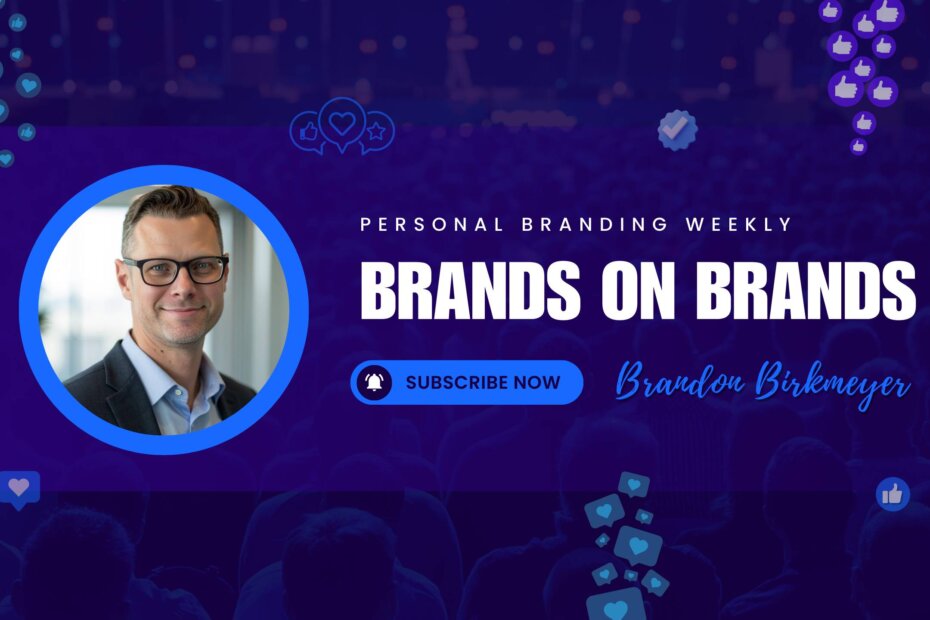This issue is presented by: The Bestselling Personal Branding Book … Front & Center Leadership by Brandon Birkmeyer
I’m an extrovert. 🥳(which I didn’t realize until I was 40) I love going to events and meeting new people. I prefer big conferences where I’m interested in the topics and I have something in common with the people. But I also like small local events where I get to connect with people in my own community. There are some events that still feel like “networking” more than building relationships, but I do my best to get through those as well as authentically as I can. I do have a confession to make. 😵 I STOPPED USING BUSINESS CARDS (until now) …for a few years because it seemed like such an outdated way to exchange information. And I always felt like those cards mostly ended up in the trash. I’ve leaned more into immediately connecting with someone on LinkedIn or Instagram and them messaging them right after the event to say hello. But after many years, I just printed out some new business cards. I’m realizing that there are some situations where I’m meeting people too quickly and may need to have cards handy to hand out so I don’t miss a chance to connect. (I still don’t like them, but now I have them)
📷 MY BIO IS A BIG PRIORITY FOR ME I have spent lots of time curating what my bio says, what pictures are shown, and different ways people access me. I know that after I meet someone, it’s the first thing they’ll see. And if I ever get referred (by a person or search results), it may mean the difference between getting the meeting and not. I’m constantly finding ways to update my social profile bios, my link in bio, my bio pictures, by pinned posts, and my bio descriptions. BONUS TIP – When I go to a big event, I make sure my latest posts and bio information are showcasing some of my best work.
📩 MY EMAIL SIGNATURE IS STILL A WORK IN PROGRESS I sometimes add a P.S. that talks about my latest work. Or I include a graphic and link to my book or podcast. In my newsletter, I’ll have a longer signature that shares my freebies and resources. But overall, I could do better at being consistent with my strategy on this.
🤯MY THOUGHT FOR YOU TODAY – the devil is in the details These tools may seem small, but when executed correctly, they can send a powerful message to your clients, colleagues, and potential partners. Let’s dive into how these seemingly minor details shape your personal brand and offer strategies to make them work for you. The Hidden Power of Your Email SignatureYour email signature is one of the most underutilized branding tools available, yet it’s something we all use daily. Beyond just offering your name, title, and contact information, your email signature should reflect your brand’s tone, style, and message. Here’s why it matters:
Signature Tips:
Crafting Your Bio: Telling Your Story in a Few SentencesYour bio serves as the elevator pitch of your brand—it’s often the first impression potential clients or collaborators will have of you. A strong bio can communicate your expertise, authority, and personal story in a way that resonates with your target audience. Here’s how to make yours stand out:
Bio Tips:
The Timelessness of the Business Card: Analog Meets DigitalIn an increasingly digital world, business cards may seem like a relic of the past, but they remain one of the most effective tools for face-to-face networking. A well-designed card not only communicates your contact details but also your professionalism and attention to detail. Here’s why the business card is still an essential component of your personal brand:
Business Card Tips:
Small Details, Big ImpactYour email signature, bio, and business card might seem like minor elements of your personal brand, but when you start paying attention to these details, you’ll find that they speak volumes. These tools are the unsung heroes of your personal branding strategy—they offer opportunities to reinforce your professionalism, showcase your personality, and extend your brand beyond social media profiles. By crafting each of these elements thoughtfully, you ensure that every interaction with potential clients, collaborators, or speaking opportunities reflects a consistent and powerful image. Your brand isn’t just what you say; it’s how you show up in all the small, everyday details. 😝Thanks for reading! Do you have any questions you’d like answered? Email me at brandon@brandsonbrands.com and let me know! Talk soon, Brandon Birkmeyer Personal Branding Coach, Bestselling author of Front & Center Leadership |








